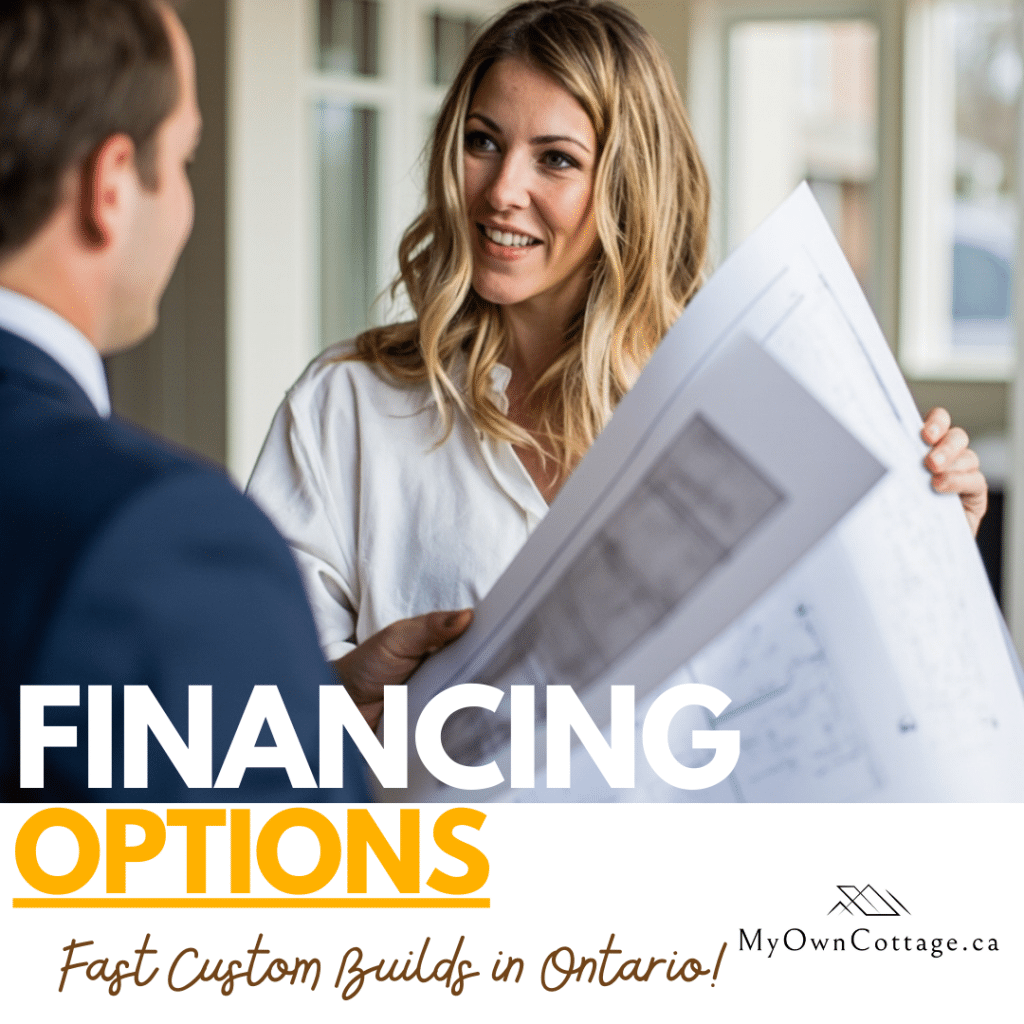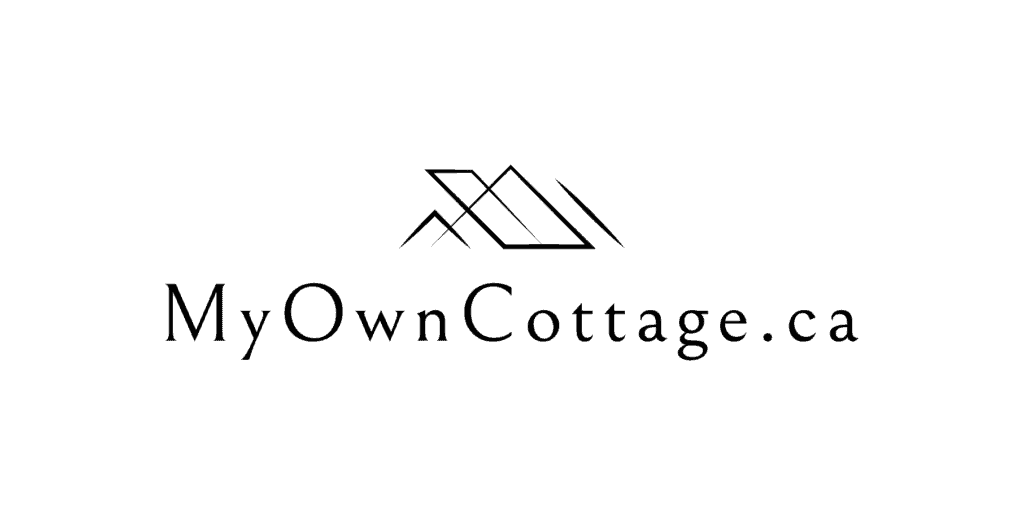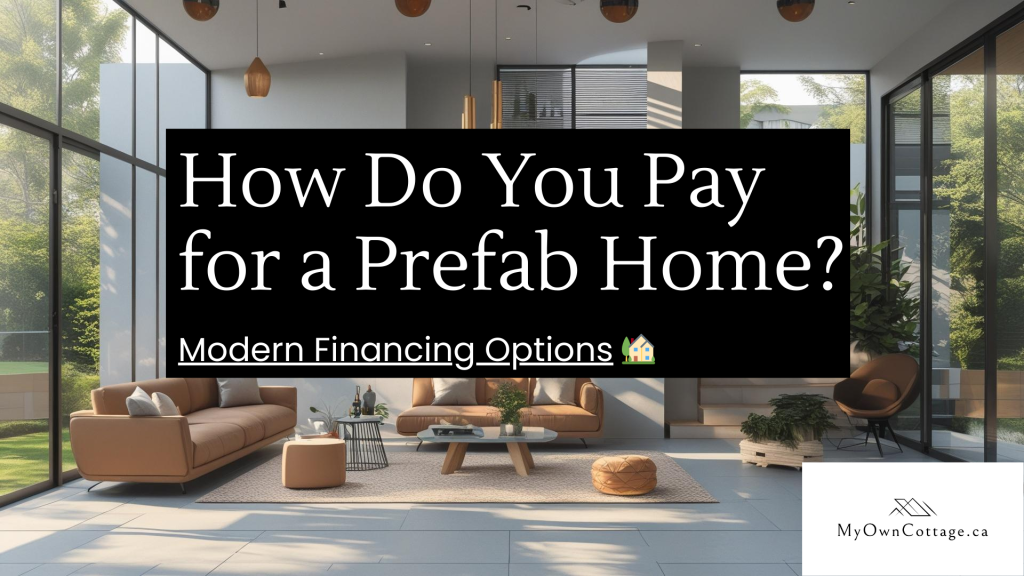How to Pay for a Prefab Home in Ontario: Financing Explained
📅 Last updated: September 10th, 2025
✍️ Written by prefab building specialists at My Own Cottage
Prefab homes—also called modular or factory-built homes—are rapidly growing in popularity across Ontario. They offer faster construction timelines and can often be more affordable than traditional builds.
Most buyers start by comparing the cost per square foot of prefab homes in Ontario.
But once you know the price range, the next question becomes critical: How do you finance a prefab home in Ontario?
Discovering How to Pay for a Prefab Home in Ontario
Financing a prefab home is slightly different from financing a traditional house, but you still have several reliable options:
Prefab-friendly mortgages – Some lenders offer mortgage products tailored to modular homes.
Construction loans – Short-term financing that covers building and assembly costs until the home is complete. Construction loans often align with prefab construction timelines and labor costs.
Builder payment plans – Staged payments made directly to the prefab company as construction progresses.
Understanding how each option works will help you choose the right path for your budget and long-term goals.
Don’t forget to include additional expenses like permits and utility hookups in your budget.
Financing Options for Prefab Homes in Ontario: Quick Comparison
| Financing Option | Key Details |
|---|---|
| Cash Purchase | ✅ No mortgage or interest ❌ Requires full upfront payment |
| Traditional Mortgage | ✅ Best for homes on permanent foundation 💰 ~20% down (lower with CMHC) |
| Construction Loan | ✅ Most common for prefab builds 💰 Funds released in stages, converts to mortgage |
| Home Equity Loan / HELOC | ✅ Good if you own another property ❌ Higher interest rates than mortgages |
| Builder Financing | ✅ Easy staged payments via builder ❌ Limited options, may cost more |
💸 How to Pay for a Prefab Home in Ontario
1. 💵 Cash Purchase for Prefab Homes in Ontario
Best for: Investors or downsizers
Pros: No mortgage, no interest payments
Cons: Requires full upfront payment
2. 🏡 Traditional Mortgage for Prefab Homes in Ontario
Best for: Prefab homes placed on a permanent foundation
Requirements:
CMHC-compliant foundation
Approved prefab builder
Typically 20%+ down payment
Pro Tip: Get pre-approved early and provide your lender with your builder’s credentials.
Link to CMHC Mortgage Loan Insurance:
👉 https://www.cmhc-schl.gc.ca/en/consumers/home-buying/mortgage-loan-insuranceLink to RBC Mortgages for New Construction:
👉 https://www.rbcroyalbank.com/mortgages/
3. 🚧 Construction Loan for Prefab Homes in Ontario
How it Works: Funds are released in stages:
Land purchase
Foundation work
Delivery & installation
Final inspection
➡️ Once complete, the loan converts into a traditional mortgage.
Link to Scotiabank Construction Mortgage (commonly used for prefab builds):
👉 https://www.scotiabank.com/ca/en/personal/mortgages/mortgage-solutions.htmlLink to BMO Mortgage Options (construction & builder financing):
👉 https://www.bmo.com/main/personal/mortgages/
4. 🧰 Home Equity Loan or Personal Loan for Prefab Homes
Best for: Small prefab units, secondary dwellings, or backyard suites
Consideration: Often comes with higher interest rates than mortgages.
- Link to TD Home Equity Line of Credit (HELOC):
👉 https://www.td.com/ca/en/personal-banking/products/credit/lines-of-credit/home-equity-line-of-credit
✅ Regional Note: Some provinces outside Ontario may offer housing incentive programs or municipal loans. Always check eligibility first.
Can You Get a Mortgage for a Prefab Home in Ontario?
Not all prefab homes qualify for a traditional mortgage. Lenders apply stricter criteria, and approval often depends on these factors:
Permanent Foundation: Most lenders, including CMHC (Canada Mortgage and Housing Corporation), require that the prefab home be placed on a permanent, CMHC-compliant foundation. Homes on temporary supports may not qualify.
Builder Approval: Banks and credit unions may ask for documentation proving your prefab builder meets regulatory, warranty, and certification standards. Choosing a lender-approved builder can speed up the process.
Loan-to-Value Ratios: If your prefab home is not CMHC-insured, some lenders require a higher down payment (often 20–25% or more). Insurance-backed builds may qualify for lower minimums.

💡 Pro Tip: Confirm with your lender that your builder is on their approved list before committing.
📌 Internal Link: See our detailed prefab homes Ontario prices breakdown to estimate how much you may need to borrow.
💵 Construction Loans for Prefab Homes in Ontario: Step-by-Step Process
Most prefab buyers use construction loans, which release funds in stages:
Land Purchase
Covers the cost of the lot if you don’t already own land.
Foundation Stage
Financing is released for excavation, permits, and laying the foundation.
Delivery Stage
Lender provides funds when the prefab modules are shipped and delivered to the site.
Completion Stage
The final draw covers installation, finishing work, and municipal inspections.
🔄 Key Difference from Mortgages: Unlike standard mortgages, construction loans are short-term. Once the home is completed, they convert into traditional mortgages.
🏦 Down Payment Requirements for Prefab Homes in Ontario
✅ Most prefab home buyers in Ontario should expect a down payment of 20%–25%. However, requirements vary depending on insurance, land ownership, and lender policies:
Standard Range: 20%–25% down payment is typical.
Without CMHC Insurance: Lenders may require higher down payments if the home isn’t insured by the Canada Mortgage and Housing Corporation.
Using Land Equity: If you already own land, its value can sometimes count toward your down payment.
🔍 Example:
If your land is worth $100,000, it could serve as the 20% down payment on a $500,000 prefab build.
🎁 First-Time Buyer Support
Ontario and federal programs may provide down payment assistance or tax credits for first-time buyers.
Link to Government of Canada – First-Time Home Buyer Incentive:
👉 https://www.placetocallhome.ca/fthbi/first-time-home-buyer-incentive.cfm
Always confirm eligibility with your lender or local government.
📌 Internal Link: Compare the average cost of prefab homes in Ontario to better estimate your required down payment.
⚠️ Hidden Costs of Financing a Prefab Home in Ontario
Beyond the down payment and financing, buyers should plan for extra expenses that are unique to prefab construction:
🛠️ Land Preparation – Site grading, soil tests, and driveway installation. Keep in mind how land value impacts prefab home costs in Ontario.
🧾 Permits & Hookups – Costs for building permits, septic system, electrical connections, and required inspections.
🚚 Transportation & Setup – Delivery fees vary by distance; setup may require a crane for module placement.
🛡️ Insurance – Coverage requirements may differ from traditional builds during construction and after occupancy.
🏡 Property Taxes – Begin once the home is installed and officially occupied.
⚡ Energy Efficiency – Many buyers ask if energy-efficient prefab homes cost more upfront. While they may, they often lead to long-term savings.
💡 Pro Tip: Ask your builder for a full cost breakdown, including estimates for delivery and setup, so you can avoid budget surprises. It’s often cheaper to build a prefab home than to buy an existing house in Ontario.
🧑🤝🧑 Case Study: How One Ontario Couple Financed Their Prefab Home
Meet Sarah and James, a young couple who purchased rural land near Ottawa and decided on a two-bedroom prefab home priced at $240,000. Their experience is typical of prefab home costs in rural Ontario.
Here’s how they structured their financing:
Land Equity ($60,000): Their land value counted toward the down payment, eliminating the need for extra cash upfront.
Construction Loan ($180,000): They secured a staged loan from Scotiabank to cover building costs.
Mortgage Conversion: Once the home was installed on a permanent foundation, the loan converted into a 25-year fixed mortgage.
📌 Smart Move: By using land equity as their down payment, Sarah and James reduced the amount of cash required at closing.
Costs can differ significantly, since prefab home prices in Toronto are often higher than in smaller cities.
❓ Q&A: Financing and Paying for Prefab Homes in Ontario
Can I get a traditional mortgage?
✅ Yes—if the prefab home is placed on a permanent foundation on land you own.
What’s a construction loan?
🏗️ A short-term loan that funds each stage of the build. Once the home is complete, it converts into a standard mortgage.
What’s a chattel mortgage?
🚐 A loan for homes placed on leased land (such as mobile home parks). The home itself is the collateral, not the land.
Are there prefab-specific loans?
🏦 Yes. Some Canadian banks and credit unions offer financing programs tailored for modular or factory-built homes.
Do builders offer financing?
🤝 Many prefab builders partner with credit unions or lenders to provide in-house financing options.
Can I pay in cash?
💸 Absolutely. A cash purchase avoids interest costs and usually allows for a faster closing.
Are prefab homes harder to finance?
🚫 Not necessarily. If the home is permanently installed on owned land, lenders typically treat it like a traditional house.
Do prefab homes qualify for first-time buyer programs?
🎯 Yes, as long as the home meets CMHC and lender standards, buyers can access federal and Ontario first-time homebuyer incentives.
✅ Choosing the Best Financing Option for Your Prefab Home in Ontario
Paying for a prefab home in Ontario doesn’t have to be complicated.
Whether you choose a cash purchase, traditional mortgage, construction loan, or builder financing, there are flexible options to match different budgets and timelines.
The key is to:
Understand lender requirements for prefab homes
Compare financing options early in the process
Factor in additional costs like permits, land prep, and transportation
Explore first-time buyer programs or land equity opportunities
With the right planning—and the right lender—financing a prefab home can be as straightforward as buying a traditional house.
Before you apply, compare financing choices, review down payment requirements, and calculate prefab home costs per square foot in Ontario to avoid surprises.
👉 Ready to take the next step?
Simply book a free consultation, call us directly or view our design catalogue to get started today.
🧑💼 Request a Free Consultation
📲 Call Us Directly: (705) 345-9337
🏘️ View Our Design Catalogue
✅ Ontario-Built | ⚡ Energy-Efficient | 🏡 Fully Customizable | 🚚 Fast Delivery
Alternatively, for your convenience, you can also simply fill out the contact form below and we’ll get back to you soon! 👇
FAQ: About Paying for a Prefab Home in Ontario
Can you get a traditional mortgage for a prefab home?
Yes. If your prefab home is built on land you own and placed on a permanent foundation, most lenders treat it like a conventional home and offer standard mortgages.
What is a construction loan for prefab homes?
A construction loan is a short-term loan that funds each stage of building and delivery. Once the prefab home is completed and inspected, it usually converts into a traditional mortgage.
What is a chattel mortgage, and when is it used?
A chattel mortgage is used when a prefab home is placed on leased land, such as in a mobile home park. The loan is secured by the home itself, similar to an auto loan.
Do prefab homes have specialized financing options?
Yes. Some lenders offer prefab-specific loans designed to cover the unique costs of modular construction, often with terms similar to traditional mortgages.
Do prefab home companies offer in-house financing?
Many prefab home builders partner with banks or credit unions to provide in-house financing. This can simplify the process, but it’s important to compare interest rates and terms.
What upfront costs should I expect for a prefab home?
Expect to pay for a down payment, deposits to the manufacturer, site preparation, delivery, assembly, and permits. These are separate from the base cost of the home.
What other costs should I budget for?
Additional costs may include land purchase, insurance, property taxes, custom upgrades (like basements or garages), and ongoing maintenance.
How do I prepare to finance a prefab home?
Save for a down payment, talk to multiple lenders, check manufacturer financing options, and consult a financial advisor to compare affordability.
Are prefab homes treated like traditional homes for financing?
Yes, if they are permanently installed on owned land. However, manufactured or mobile prefab homes may face stricter lending requirements.
What documentation do I need to get financing for a prefab home?
You’ll need standard loan documents: pay stubs, bank statements, tax returns, and a credit report. Some lenders also request builder contracts and site details.
Can you buy a prefab home with cash?
Yes. Paying cash eliminates loan interest and speeds up the process, though most buyers still choose financing to preserve liquidity.
Do prefab homes qualify for first-time homebuyer programs in Ontario?
Many prefab homes qualify, provided they meet CMHC and lender requirements. Always confirm eligibility with your lender and builder.
How long does prefab home loan approval take?
Approval usually takes 2–6 weeks, depending on whether you’re applying for a construction loan or a traditional mortgage.
Are prefab homes harder to finance than traditional homes?
They can be, especially if not permanently affixed to land. However, prefab homes with proper foundations are increasingly accepted by lenders.
Is a prefab home cheaper to finance?
Not necessarily. Interest rates are similar to traditional homes, but costs vary depending on land, construction, and lender risk policies.
Can you refinance a prefab home loan?
Yes. Once your prefab home is classified as real property, you can typically refinance with most lenders, just like a site-built home.
What credit score is needed for prefab home financing?
Most lenders require a credit score of at least 620–680, though higher scores may qualify you for better mortgage rates.
Can prefab homes be financed through CMHC?
Yes. CMHC-insured loans are available if the prefab home is permanently attached to a foundation and meets Canadian building standards.
Do prefab homes appreciate in value like regular homes?
Yes. When installed on permanent foundations and maintained well, prefab homes generally appreciate at a similar rate to traditional houses.
How much down payment do I need for a prefab home in Canada?
Down payments are typically 20% or more, especially if the home is not CMHC-insured. First-time buyers may qualify for incentives to reduce costs.
Can you pay for a prefab home with a HELOC?
Yes. Some buyers use a Home Equity Line of Credit to fund a prefab purchase, especially when leveraging equity from an existing property.
What documents do I need for prefab home loan approval?
Lenders usually request proof of income, tax returns, credit history, bank statements, and builder contracts to process financing.
🛡️ Verified Third-Party Resources
For added confidence and transparency, here are trusted external sources that support modular homebuilding in Ontario:
Ontario Building Code (O. Reg. 332/12)
Official provincial regulations that govern modular and factory-built homes.Tarion Warranty Corporation
Provides home warranty coverage and builder licensing in Ontario.Canadian Home Builders’ Association (CHBA)
National organization supporting residential construction, modular certification, and best practices.CMHC – Canada Mortgage and Housing Corporation
Federal housing authority offering insights on modular housing affordability, financing, and energy efficiency.Statistics Canada: Housing Data
Data-driven research on Canadian housing trends, ownership, affordability, and construction.


